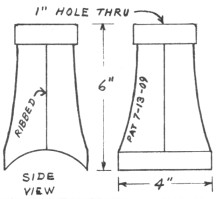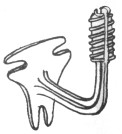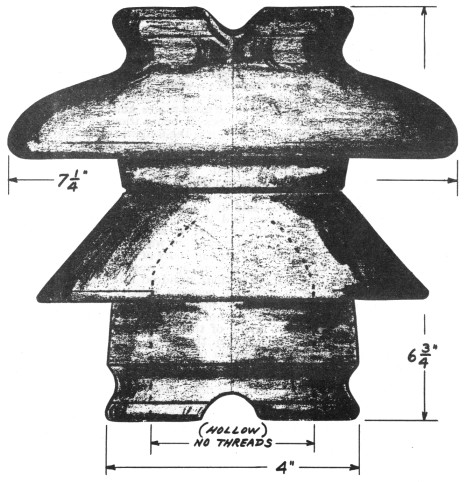Porcelain Insulator News
by Jack H. Tod
Reprinted from "INSULATORS - Crown Jewels of the Wire", May 1977, page 20
Dear Jack:
Two years ago, searching along the roadbed of an old Electric Railroad, we
found some old "strains" about 3-1/2" by 4" long. We found
about 3 kinds of colors in these: Mottled brown, brown-and-black, and metallic
blue-black. These have a rough "fused" looking place on one end. They
evidently are old types, as we found near them some iron insulator
holders dated "PAT. 7-13109".
We could have found more strains in a swampy area, but did not hunt this
swawp area very much.

This year I told my wife and boy I thought it would be worthwhile (especially
in a dry year) to get more of these in the swampy area, as we never found
any strains this old looking -- and we hunt quite a few abandoned and
semi-abandoned railroads.
My wife and boy are in doubt if it would be worthwhile to go -- just to pick
up more of these strains. This time I would also pick up more of the iron
holders dated 7-13-09.
Do you think it would be worthwhile to hunt more of these, and what
approximate trade value would you put on old strains such as these?
Harold Barkley
Barkley Museum,
Taylor, MO 63471
- - - - - - - - - -
Dear Harold: The cast iron pins are undoubtedly Patent No. 927,701,
July 13, 1909, inventor F. Woodmansee (assignor to Electric Service Supplies
Co., Phila., Pa.), "Cast pin and base". This is the base part only of
the entire pin assembly.
The strain insulators are probably Locke items of 1910-20 vintage, and the
rough surface on one end is the place where they sat when fired.
The cast iron pin bases are probably a desirable collector item, but I have
no idea of what cash or trade value you could get for them.
The strains are something else. They are a rather ho-hum porcelain item
unless of very unusual design or with some early or unusual porcelain company
markings. Even then, most collectors just collect strains as a go-with and don't
chase after them to form large general collections of strains.
I don't really think it would be worth your while to go after more of these
if it's a matter of valuing the rewards of "work". However, it is
impossible to measure the immense pleasure value your family gets from the
scrounging -- a weekend away from the world's troubles, maybe steaks broiled
over the hardwood coals, looking up at the stars from a warm bedroll,... Even if
you come home and toss the items on that ever-growing pile of "junque"
behind the garage, you're still way ahead of the game in my judgment.
Jack
Dear Jack:
Just found a U-923. It's the normal white glaze cross-top with F. M. Locke
marking in the top grooves, but also with something I've never seen before.
Along the bottom of the skirt is an Imperial handstamp marking (MANUFACTURED BY
/ IMPERIAL PORCELAIIN WORKS / TRENTON, N.J.). These may be common, but I've
never seen the Imperial marking before.
Also the pin this was mounted on was with it. It's an L-shaped pin marked
CHUBBUCK PAT. SEPT 9. 90. Can you please give me an idea of the value?
Tom Kasner,
Bend, Oregon
- - - - - - - - -
Dear Tom:
The U-923 were made by Imperial for Locke several years before Fred Locke
started manufacturing insulators at Victor, and all of them I've ever seen have
both the F. M. Locke marking in the top cross-groove and the Imperial marking on
the flat area at the bottom portion of the skirt.
In my book we list the white U-923 with both these markings at $25 value. The
values suggested by the four people working on the pricing were $20, $20, $25
and $35.
The "Insulator-Bracket" is patent 436,120, Sept. 9, 1890, H.
Eugene Chubbuck, Springfield, Ohio. The sketch at the right is from the patent
drawings.

One could form an interesting collection of "pins" that would be as
large a collection as the insulators themselves, and I'm sure some people do
just that. It is easy to compile information on the origin, since there are
hundreds of patents covering virtually every pin from the very early ones up to
the modern types.
Your 1890 specimen would be a desirable early classic to pin collectors, but
I don't have a feel for its value.
Jack
Dear Jack:
We recently acquired a porcelain which I cannot find any information on. I
have your book but just can't match it with any. I am told that it came off
railroad power. It's a No-Name, has no threads, and is a dark blue. I'd really
like to know something about it.
We enjoy your news every month and thank you for your help.
Noel D. Hatfield
Box 75, Stromburg, Nebr. 68666

- - - - - - - - -
Dear Noel:
Sorry, I'm stumped, but maybe one of our readers can help us with an answer
on this unusual insulator.
Your drawing is a real work of art. Maybe we should put you on the Crown
Jewels staff to make our insulator drawings.
Jack
W. M. Hunter (DuBois, Pa.) recently sent several 1898-1900 issues of
"Mines & Materials" (a trade journal) and thought there could be
something of interest to subscribers.
The March 1898 issue had an article which could bear fruit for insulator
collectors. It gives some clues which could possibly lead some of our hardier
Canadian readers to a very long line of old abandoned goodies (maybe even
threadless) -- or to what could end up being a very long wild goose chase. We'll
reproduce below the entire article and leave it up to you to interpret whether
it could be insulators or wild geese.
A Telegraph Line to the Klondike
C. R. Hosmer, who a short time ago inspected the western portion of the
Canadian Pacific telegraphs, says that the construction of the Klondike
telegraph will be a comparatively easy matter. There is, he says, a certain
amount of what might be called "romance," from a telegrapher's
standpoint, in connection with this Klondike development.
Away back in 1863-4 an enterprise was organized which had the ambitious
object of connecting the United States and Russia by telegraph, with a cable
across Behring Sea, it being thought at that time that this distance (about
forty miles) was the longest that a submarine cable could be operated; 1865 saw
the work organized, and the promoters expected to see the line in operation by
the end of 1867, and the most sanguine results were predicted.
The charge for telegraphing was to be $25 per message, and the receipts from
the business were estimated at $9,000,000 per annum. What was known in those
days as Russian Extension stock was sold at a premium of 60 per cent. The line
between New Westminster and the Yukon River was surveyed. and found to be quite
practicable, and it went right through the present Klondike region.
The telegraph line was actually constructed from New Westminster, along the
present route of the Canadian Pacific Railway, to Ashcroft, where it was
continued north towards Behring Sea to Fort Stager, some three or four hundred
miles beyond Quesnelle. This line is now in operation between Ashcroft and
Quesnelle in the Cariboo country.
The surveys made show that the line between Ashcroft and the Behring Sea
could not only be constructed, but easily maintained. The successful laying of
the Atlantic cable knocked the Russia-American telegraph line on the head, and
the work was abandoned after some three millions of dollars had been expended.
George Kennan, who was a telegraph operator working on the Siberian end of
the line, very pathetically tells of the company's ship "Onward"
bringing to him in far-off Siberia the news that the Atlantic cable was a
complete success, and that the project of an overland line to Russia had been
abandoned. He said it seemed hard to give up at once the object to which they
had devoted three years of their lives, and for whose attainment they had
suffered all possible hardships of cold, exile, and starvation on the Siberian
end.
By September 1st he calculated that he would have been able, with the forces
at his command, to have had a thousand men at work. Mr. Hosmer believes that
some day this Klondike telegraph route may form a practical route for a line to
China. In fact, he himself endeavored in 1889 to reawaken the Russian
Government's interest in the matter, and he has no doubt that when this line
once goes to Dawson City the connecting link between that and the Russian
systems will be again taken up.
The estimated distance from Quesnelle to Dawson City is 1,400 miles. It is an
easy trail, and there is small timber along the greater portion of the route,
which might be used for telegraph poles. Mr. Hosmer has no doubt that during the
coming year the most important sections of this line will be built.--The
Canadian Engineer.
| 